Pasture Management
Horses are designed to derive their nutrition from a constant trickle of coarse, fibrous material: grazing and browsing on a variety of grasses bushes and trees found growing on low fertility ground.
Confining them behind fences, forced to eat the unbalanced regrowth or the fertilised ‘improved’ grasses and clovers of modern agriculture is unnatural and a danger to your horses health.
It is only over the last few years that I have realised there is such a thing! All our lives we thought that all you needed to keep a horse was a nice grassy paddock, the greener the better!
If you stick to the following principles your horse will live a longer, useful life instead of developing a sagging back, arthritis or cushing’s disease well before they reach the age of twenty.
Pasture Management
Never apply commercial fertilisers: no super, no nitrogen, no NPK, no urea and no potash.
They will all cause the grass to be even more unsuitable for your horses.
For a while we thought it was just a case of getting rid of the ‘baddies’ (mainly rye/clover/paspalum) and re-sowing with more horse friendly grasses. Whilst this is still a gigantic step in the right direction......
It is not just a case of sowing the right grasses.
Equally important is the stage of growth of this grass.
Grass which is either very short, in rapid growth mode, or stressed by weather conditions is not suitable for horses because it becomes seriously out of balance in some critical minerals. This imbalance disturbs the normal functioning of the horse’s nervous system and precipitates a cascade of problems.
These same conditions favour the proliferation of moulds and fungi, many of which are invisible, and which produce mycotoxins that are potentially harmful to the health of your horses.
There are two different approaches to the whole subject of pasture management depending on what sort of horses you own. If you just want the quiet ride at the weekend and safe ponies for your children then you will do things differently from someone who has performance and/or breeding horses.
Breeding and Performance Horses
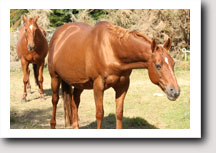
Objective: To maximise conception rates, reduce the incidence of abortions, birthing problems, laminitis, limb deformities and DOD’s and reduce animal health bills.
Eliminate all clover and rye-grasses
This may require some long term planning. It can be done progressively, paddock by paddock. Well worth it in the long run.
Why no Rye or Clover?
Changing to Safer Pastures
No high octane commercial fertilisers!:
- no super, no nitrogen, no NPK, no urea and no potash.
- Grass needs potassium and nitrogen (in the form of nitrate) to grow but commercial applications of these elements will cause luxury uptake by the grass, rapid growth and upset critical mineral ratios in the horses leading to reproductive and other health and behaviour problems.
- The theory of using clover to supply nitrogen to the soil does not work well for horses. There will be explosions of clover growth and this will supply much higher levels of protein and potassium than the horses require.
- Grass in early spring is too high in water, nitrates and potassium and very low in calcium, magnesium, copper and sodium.
Calcium, magnesium and sodium, along with their essential co-factors which include phosphorous, boron, Vitamin D and copper are all required for proper formation of the skeleton and other tissues of the foal.
Right at the time when the requirements of the pregnant mare and her growing foal (which doubles in size during the last trimester) are at their highest, the grass is at its worst for supplying them!
Mares and growing youngsters are particularly prone to mineral imbalances caused by the over-supply of potassium which suppresses sodium and calcium uptake.
- Therefore it is vital to add these nutrients to the daily feed of broodmares, stallions and growing youngsters. Adding salt, XtraCal and Premium NZ Horse Minerals (Supreme Vit & Min for Aust) to a simple beet-based feed which can be placed on a slice of hay out in the pasture is a simple way to ensure both fibre and nutrient requirements are met.
- As spring progresses to summer, less potassium is taken up by the plants and consequently the proportions of sodium, calcium and magnesium in the grass all rise. In other words as the grass matures it becomes much more suitable horse fodder.
‘Hormonal’ Issues
These are extremely common and caused by the 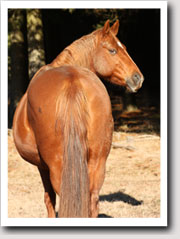 same imbalances. Over the years, I had had my fair share of experiences with ‘moody mares’.
same imbalances. Over the years, I had had my fair share of experiences with ‘moody mares’.
There is no need for drugs and/or ‘moody mare’ products when you get the basic nutrition right.
See Recommended Diet Changes
Read Sabrina’s Story
Reproductive Problems & Developmental Orthopedic Diseases
Dr Thomas Swerczek, a prominent veterinarian from Kentucky was one of the vets in attendance during ‘Mare Reproductive Loss Syndrome’ back in 2001 in Kentucky and neighbouring states.
There was found to be strong evidence that the cause was due to ‘potassium spikes’ in the pasture grasses due to late frosts and freezes that season. The resulting severe electrolyte imbalances, the same ones that caused cattle to die of grass tetany on neighbouring farms, was also thought to be the cause of the very high incidences of abortions, still births and limb deformities in the breeding thoroughbreds that particular year.
Since this conclusion was drawn astounding results have been achieved by the force feeding salt and sodium bicarb to mares on stud farms. [1]
Tendon contractures were not uncommon on a stud where the predominant grass was Kikuyu. Mineral imbalances - in particular calcium and sodium deficiencies, are likely huge contributors.
MRLS occurred during a season of ‘extreme’ conditions but it does not take rocket science to put two and two together.
Most studs periodically experience their share of lower than expected conception rates, abortions, limb deformities and yearlings with developmental orthopaedic diseases which whilst not of catastrophic proportions as in MRLS, are strongly correlated with the same phenomenon only less extreme. It seems to be another case of ‘common’ coming to mean ‘normal’!
Nobody seems to question the fact that yearlings going through the Karaka Sales have to have their accompanying X-Rays for Developmental Orthopedic Diseases. Many are booked in the have bone chips removed soon after. Many have poor quality hooves.
This could be attributed to the lack of understanding of how changes in the physiology of the grass with season and weather affect the pregnant mare and her developing foal.
To Harrow or Pick Up Manure on your Small Block?
HARROWING is a NO-NO!!
Never harrow manure on paddocks intended for grazing. Just leave the manure as it is supposed to break down very slowly. Stock will not eat the grass growing where they have dropped manure because it is loaded with potassium and nitrogen and will cause metabolic problems.
Spreading it increases microbial activity and will increase potassium levels in the plants significantly.
Pick up or leave the manure to slowly break down over the course of a year.
Nature knows best.......
If God intended the manure to be spread he would have attached a ‘spinner’ to the back end!
Rotating Paddocks
When horses are shifted onto a fresh paddock of re-growth their manure tends to soften or even get sloppy. This indicates not only inflammation of the gut-lining but also serious upset to the gut flora.
A corresponding horizontal ‘ring’ around the hooves which represents the damage to the laminae which happened at that time soon becomes eveident.
Absolutely avoid putting horses on any ‘fresh grass’ or re-growth especially in spring and autumn.
Instead, save a paddock from autumn and allow it to grow slowly all winter. This will then be ideal for your breeding horses to graze in spring.
Fresh spring grass is potentially harmful to mares and unborn foals, the inherent mineral imbalances can cause abortions, birthing difficulties and limb deformities.
Ask your contractor about applying salt to the pastures in late winter/early spring. This will help to minimise the effects of potassium and nitrogen spikes. A good idea for all livestock not just horses.

Zephyr - rising two here, bouncing around on 'perfect horse grass'.
Recreational Horses
Should You Change Your Grasses?

If your property has been part of a dairy farm in the past or the pasture consists of solid rye-grass and clover then YES. You should nuke the lot with a mixture of Roundup and a good broadleaf spray.
read...
Changing to Safer Pastures
If your pasture is composed of a variety of grasses but there is some clover then you may only need to use a ‘Broad-leaf’ spray to get rid of the clover component along with any weeds. These sprays will also knock the plantain but don’t worry, it comes back. You will need to talk to your local agricultural contractor, (most use one called ‘Granstar’ which works very well).
It will take 10 days – 2 weeks for the spray to work so you will need somewhere else to keep the horses over this time.
Spraying out clovers annually (early spring) will be an essential part of your pasture management
More on the types of good grasses here
If it is your own property then it is well worth investing some resources in building a good, safe ‘Dry Lot”
(Click on Dry Lot Options)
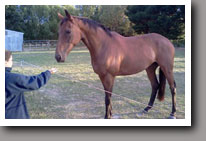
This horse became very spooked on the short green grass he was grazing.
After evaluating the grass situation and making the appropriate changes it is best to let it grow to a good length, at least 10” or more. The more mature the grass the ‘stalkier’ it is. This means it is higher in fibre relative to soluble sugars and the more minerally balanced (less potassium, more magnesium).
However grass can get over-mature too. The composition of the cell walls (bricks and mortar) of the plant determine fibre quality. Cell walls are made up of hemi-cellulose, cellulose and lignin. Over-mature grass has a high lignin content and since lignin is indigestible you don’t want grass to over-mature. Lignin generally doesn’t become a problem until after the grass has dropped its seeds in late summer.
Stop your horse eating
- fresh spring growth. It has a comparatively high water content (which exacerbates the lack of sodium), is lower in magnesium, and is higher in potassium and nitrogen. No wonder horses have problems in spring.
- New green shoots that pop up after a dry spell (usually autumn). These can be particularly dangerous being chokka full of potassium and nitrogen
- Rye-grass (Perrennial) and Paspalum seed-heads. They can be laden with pathogenic fungi (endophytes and ergots) which produce myco-toxins potentially very harmful to your horse
Control access to grass:
- In spring when you want to grow hay then your horse(s) will have zero access and live 100% of the time in their Dry Lot.
- At times when your grass is green and prolific then you may only allow access for 10mins morning and night.
- After the hay is taken off and the grass has dried off you may allow access for more hours of the day or night as you see fit
- In late summer especially when there are long dry spells they may be able to go on the grass full time.
Feeding Graze Ezy will help your horse cope with the grass for more of the time. The challenge is to know how much to feed on any given day because requirements will vary with the changes in the weather.
You will get to know what suits your horse on your grass and work out a routine to fit your daily schedule.
What About Strip Grazing?
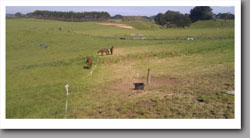
This works for some people on some properties so long as you can ‘back-fence’.
Points to Remember:
- horse(s) will scoff the fresh bit in the first hour or two then spend the rest of the day nibbling on the re-growth which can cause problems. You could try putting hay out for them to eat too.
- With strip grazing the grass is eaten down pretty short and then takes a long time to recover. Back fencing helps as the grass they ate yesterday can immediately start growing again.
- You can’t have too many horses grazing the same strip as the back fence means it is a narrow space
- Your electrics need to be working well.
What about “Jenny Craig” paddocks?
Eeeek!!! These are an absolute ‘No-No’!

- If you aren’t feeding any hay and your horse is confined to such a paddock, it means your horse’s diet is 100% tiny grass tips which as you have now learned are very unbalanced mineral-wise and therefore totally unsuitable horse feed.
- These tiny grass tips, especially in spring and autumn are likely to actually cause a laminitic attack
- Jenny Craig paddocks are ‘starvation’ paddocks and if that is all your horse or pony has to eat then you are in effect starving them of essential nutrition.
- They do nothing to help ‘metabolic’ or cresty, laminitis prone horses and ponies, in fact they make them worse.
Instead you need an area with no grass (See Dry Lot Options ) and a good supply of hay. Then you will see the metabolic symptoms disappear, you won’t have any more episodes of laminitis or sore feet. You will be able to enjoy your horse and pony as you should.
Over-Grazing
The shorter the grass is grazed, the longer it takes to recover and grow again. In fact over-grazing actually wrecks the grass. It is a very common scenario on horse properties because there isn’t sufficient land available to rest paddocks for long enough. When grass gets too short there isn’t enough leaf area to produce the nutrients to sustain the plant and they become stunted and more susceptible to damage by hooves. Bare patches also appear especially where horses ‘hang out’ and erosion starts.
Rented Grazing
This can prove to be a difficult situation if your horse develops problems because you cannot control grass intake...
Things you can do to help:- Make sure your horse gets some hay every day even if you have to leave him in a tape pen to make sure he gets it
- This is particularly important when they are moved onto a fresh paddock. Keep a close eye on his manure.
- Feed all the ‘goodies’ to help balance electrolytes: salt to provide sodium and chloride, AlleviateC to provide organic calcium and magnesium, GrazeEzy to help neutralise the potassium/nitrogen spikes in the grass with changes in the weather or season, and Premium NZ Horse Minerals or Supreme Vits and Mins (for Australian horses)for everything else including selenium. The idea is to cover all bases to help prevent problems at various times of the year rather than trying to fix them.
- Feeding all the goodies will at least minimise the problems and even prevent many. However if your horse has a chronic problem like being prone to laminitis, or head-flicking, or respiratory problems then you may have to look for alternative grazing where there are yards you can use as ‘dry lots’ during times when the grass is unsuitable for your horse.
- Have the owner or manager of the property study this website so they understand where you are coming from. Hopefully then they then may at least spray out the clover and weeds and even more importantly they will not fertilise with commercial fertilisers!
Some notes on Magnesium
It takes around 70kg/ha to maintain the Mg levels in pasture.
Mg is used as a tool to get the ratio of air and water in the soil correct.
If the soil is cracked and the edges are sharp and fit together well it is a sign of Mg deficiency in the soil.
If the edges are rounded and are uneven it is most probably Sodium deficiency.
If you are thinking of Renovating Horse Pastures:
Here is some helpful information from “Pastoral Improvements”, Canterbury...
Target the paddock.
It is best to only replace a small percentage of your grazing area at one time (an area you can do without until late spring).
The earlier in Autumn the paddock can be sown the better - before soil temperatures decline and to take advantage of Autumn rains.
The reality is that the establishment of healthy, safe, specialist horse pastures is a process and takes the best part of a year. You only get one chance to establish new grasses so it is essential to follow these instructions diligently.
For direct drilling, oversowing into an existing old pasture:
Once you have decided which paddock you are going to renovate, it is important to have it sprayed out for grass and broadleaf leaf plants as soon as possible. Even if you have some good grasses already there you need to knock them back in order to give the new grasses a chance to establish.
You or your contractor should apply:
* 5 lt Glyphosate per Hectare, which is a knock down broad spectrum herbicide (also known as G360, Round up, Turbo)
* 40 grams Granstar per Hectare, which is a targeted broadleaf herbicide.
* 100-200ml Pulse, or other wetter, sticker product that enhances the spreadability and uptake of the chemicals, ensuring a better knock down.
* Mixed with 200lt water per Hectare
Allow 3-4 weeks for the paddock to brown off
Sow the paddock. Arrange for your contractor to apply the appropriate pasture seed-mix
( Some examples of good grasses to sow are found here... http://calmhealthyhorses.com/grass/good_grass.html ) at a very shallow depth (10mm) but well covered. Otherwise the birds will have a feast! Sow at the per hectare rate on your bag. Give your seed all the help it can get by using biological and/or insecticide treated seed.
You should continue to monitor your young horse pasture for insect damage. It is a good idea to monitor under the turf and dung for slugs. If significant presence is noticed, be proactive with additional insecticide and/or baiting treatments.
When establishing pasture, weeds competing with the new grass are the enemy.
When your newly established pasture is about one inch tall and weeds have struck, use a selective herbicide to control these newly struck weeds:
Your contractor should apply:
* 2-3lt MCPA per Hectare
First grazing
Brand new grass of any species is very ‘potent’ and can be very harmful to horses. First grazing, when the grass is just a few inches tall should ideally be by sheep who will nip off the tops. (Ruminants are not as susceptible). Otherwise mow it. Taking the tops off will divert more energy to the roots so they will strengthen up and reach down deeper.
Ideally take a cut of hay off the new grass next spring. Only allow gradual access by your horses once the grass ‘dries off’ late spring/summer.
Mares refuse to suckle
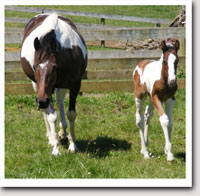
Such was the case with the coloured mare in the photo above.
She didn’t want to know the foal at first. Whilst waiting for the vet to arrive her owner syringed in a good tablespoon of Alleviate C (which contains organic magnesium, boron and calcium) which relaxed the mare and reduced her discomfort and she allowed the foal to drink within an hour.
 Calm Healthy Horses
Calm Healthy Horses